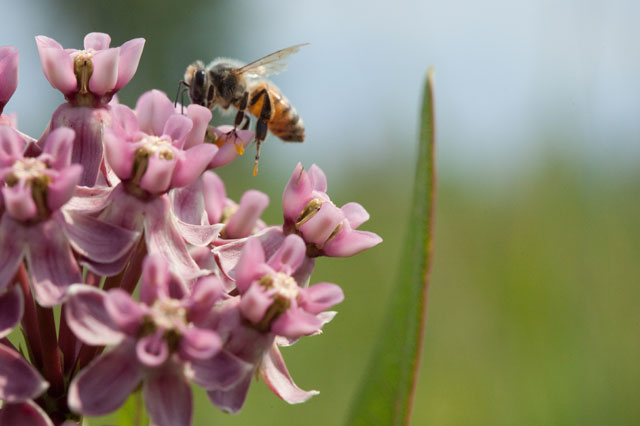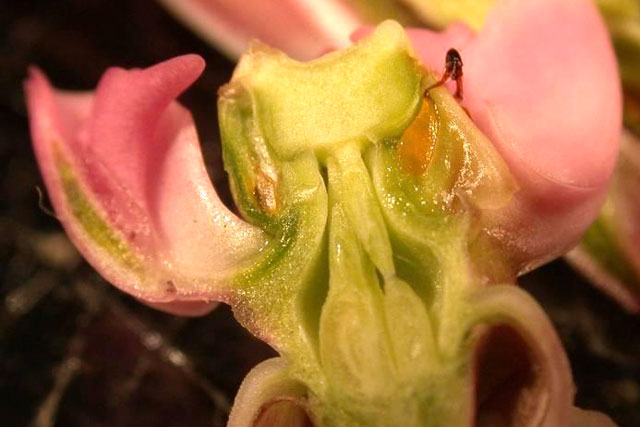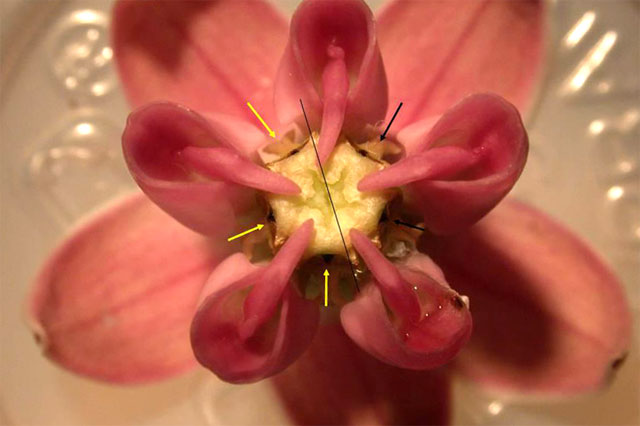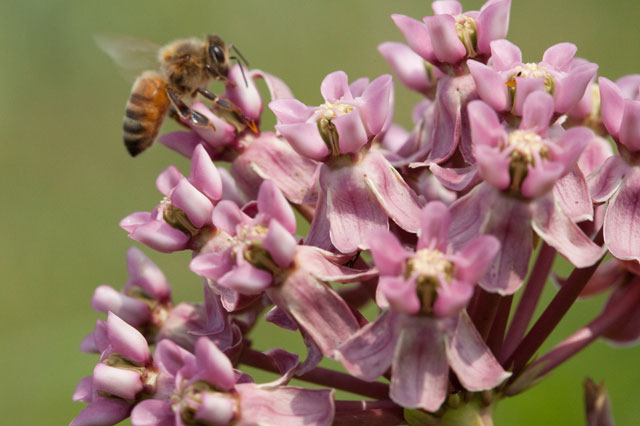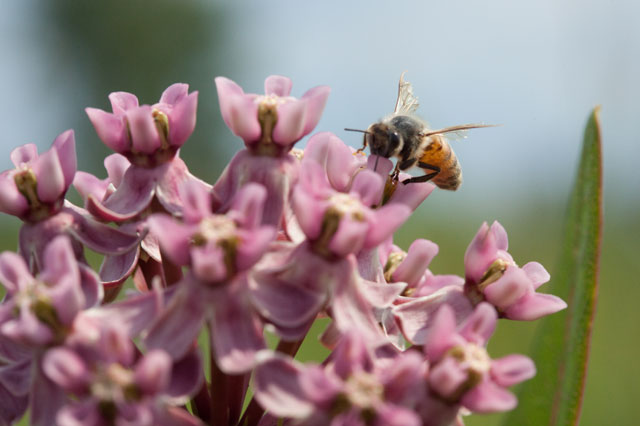 |
 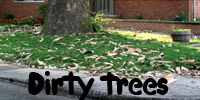 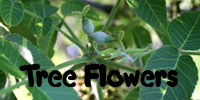 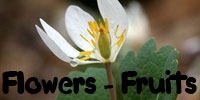 |
Welcome
to bobklips.com, the website of Bob Klips, a plant enthusiast living in
Columbus, Ohio. ..................................................................................................................... Green
Katydid at Killdeer Plains Wildlife Area!
(and a book recommendation) July 16, 2009 While examining
Sullivant's milkweed
plants at Killdeer Plains in Marion County, Ohio, I chanced upon this
very ununusual color form of a katydid. Unlike the familar
pink katydid, this one's bright green! "Greeny"
obviously isn't long for this world because he stands out like
a
sore thumb among the pink milkweed buds and flowers and thus is sure to
become dickcissel dinner. (There really are dickcissels here.) But
wouldn't a sore thumb be pink? Anyhow, I estimate this sighting to be a
1 in a 1.000002 occurrence.
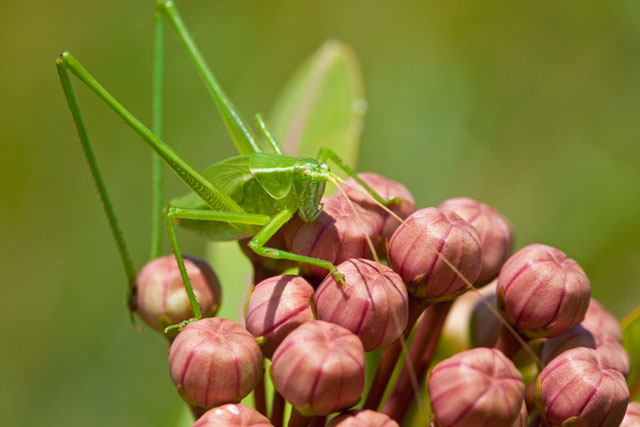 Very rare (raw, completely uncooked) green katydid at Killdeer Plains. July 17, 2008. There is a lot of
interest lately in
identifying nature things other than just the
traditional wildflowers and
birds. Lots of people are getting quite good
at field-recognizing
butterflies, moths, dragonflies, and various Orthoptera. This
is thanks
in part to the recent issuance of some excellent field guides,
and
also to the establishment of regularly held surveys, or special
one-time
surveys, of groups that, until recently, were the exclusive purview of
experts.
For example, an upcoming event in New York City, to be held on the evening of Friday, September 11, 2009, will marshal a slew of volunteers to survey a certain seven singing insects! It's the "NYC Cricket Crawl," described by its organizers as "An aural expedition and a celebration of life in the leafy jungles of urban and suburban NYC and surrounding area." The peppy and smart website for this great event includes a list of the 7 target species with links to calls and pictures. The calls and pictures are courtesy of Will Hershberger and Lang Elliot, who also have a super website (with a "jukebox!") that is a companion to their awesome book "The Songs of Insects," a book that is simply AMAZING!! Big and beautiful, it has descriptions and natural history info about all the common eastern singing insects --two pictures each, one a "studio" shot with a white background and the other in a natural setting --range maps, sonograms, and a CD. And it's super-cheap ...order today for only $13.95 at Amazon.com!! 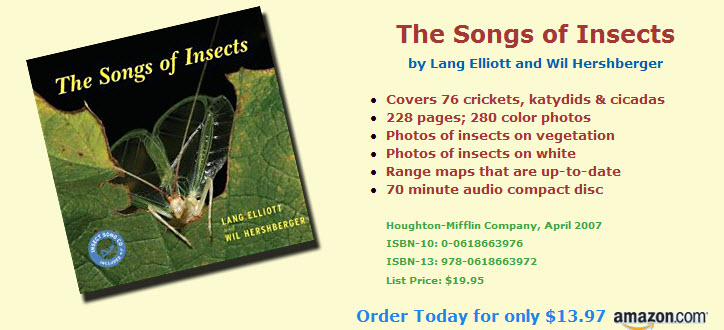 Book recommendation,
great way to learn the sounds of late summer.
The book tells me that "Greeny" is actually a "false katydid" in the genus Scudderia, one of the so-called "bush katydids." The species of Scudderia are difficult to distinguish except by examining the shapes of the male's tail plate, a feature my picture doesn't show. Elliot and Hershberger also tell us that "male bush katydids produce sperm packets that are accompanied by a large, edible gelatinous mass. After mating, the female consumes this 'nuptual meal' while the contents of the male's sperm packet are emptied into her." There is fascinating and beautiful info in this book. It is a great value. Moth Mullein Morral, Marion County, Ohio July 7, 2009 Speaking of moths,
there's a plant named "moth mullein" in the figwort
(snapdragon) family, Scrophulariaceae. It's a
European weed that is well established in fields, roadsides, lawns and
waste places, including a roadside near a field in central Ohio.
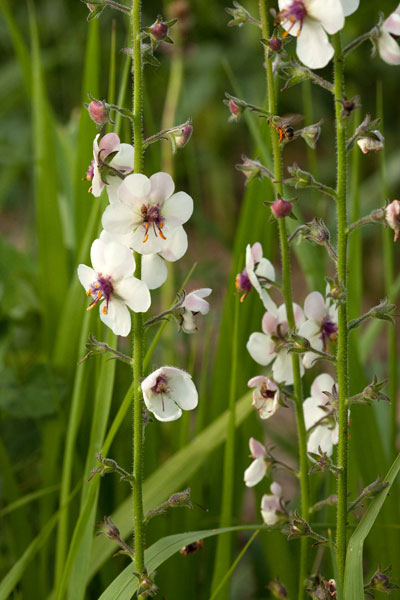 Moth mullein. July 7, 2009. Marion County, Ohio Although Verbascum
is non-native, this species at least seems attractive to (presumably)
native pollinators. Below a small and out-of-focus
bee approaches a blossom.
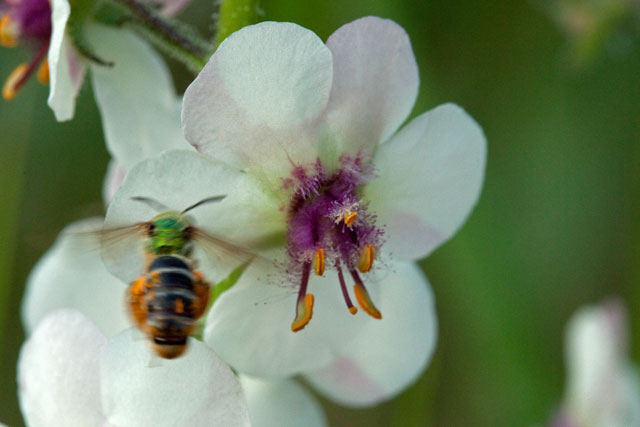 Moth mullein being approached by a bee. July 7, 2009. Morral, Marion County, Ohio. Why is it called moth
mullein? Probably not because of any association with moths. It might
be because the filament portion of the stamen is plumose, like a moth's
antennae. Anyhow, this morning the predominant flower visitors were
neither hymenepterans nor lepidopterans, but dipterans ...little flies
(order Diptera) in the family Syrphidae, variously called syrphid
flies, flower flies, or hover flies. Like many flies,
these have sponging-sucking mouth parts. They are often seen
doing their sponging-sucking on pollen grains at an anther
(pollen sac), like so:
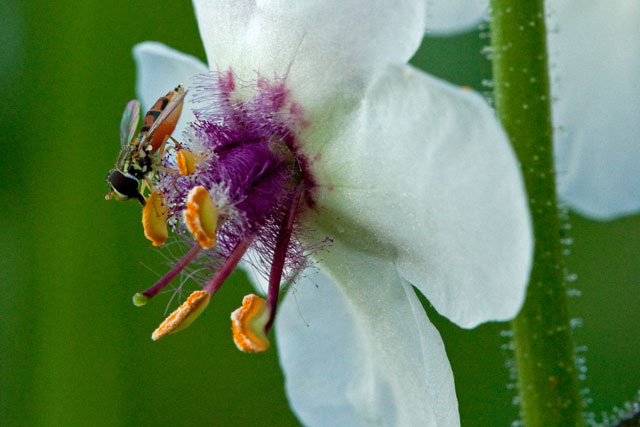 Syrphid fly sponging-sucking moth mullein pollen in Morral, Marion County, Ohio. July 7, 2009. Here's a video of the
same thing. It's not clear from this observation how this all works.
Even though the mouthpart looks somewhat Electroluxy, the pollen grains
aren't sucked up, are they? The sponging-sucking mechanism is, I think,
supposed to dissolve some nutrients that then get imbibed in a liquid
form. What's on the outside of pollen grains,
readily
soluble, that can feed a fly?
Another question --do these guys pollnate? The first half of the video below shows the fly merrily sponging-sucking an anther, while the slender style is standing nearby quite untouched. Later, "Syrphy" diligently sponge-sucks invisible and non-existent nutrients off the stigma. But during all this, does any pollen get deposited either on the fly (male function for the flower) or on the stigma (female function)? It doesn't look like that is happening. Syrphid fly feasting
on pollen at moth mullein, July 7, 2009.
Flies, in the
appropriately named order
Diptera ("two-winged") have their rear wings modified into knob-like
balancing organs called "halteres." These reduced modified wings are
evident in the picture below.
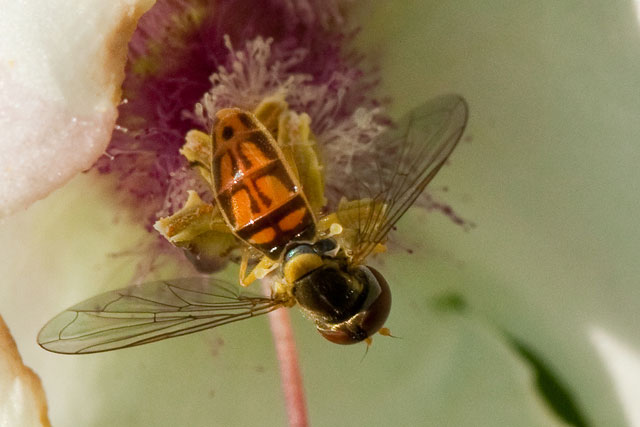 Syrphid fly on moth mullein. July 7, 2009. Note the knob-like modified hindwings, characteristic of all flies. Midnight Milkweed Madness! July 7-11 2009 Killdeer Plains Wildlife Area, Marion County, Ohio At Killdeer Plains
Wildlife Area in north-central Ohio, an otherwise quite uncommon
prairie plant, Sullivant's milkweed, Asclepias sullivantii
(family Asclepiadaceae) is widespread and abundant.
Alongside common
milkweed (A. syriaca),
which also occurs here but is less common, Sullivant's begins flowering
during the last
few days of June. The blooming period extends for 3-4 weeks,
peaking in the first 2 weeks of July. As mentioned here last year,
and also described in the "follicles"
section
of the page about fruits in the "Flowers and Fruits" section, milkweed
pollination is extraordinary. The
flowers are highly modified. The pollen, instead of being distributed
as individual grains that might separately go off to sire seeds on
several-many different plants in the population, is adherent
in
coherent masses that get delivered en masse to
the
stigma of a
flower. The genetic result is the unusual situation among plants where
all of the seeds in a many-seeded fruit are full-sibs, i.e., they
have not only the same mother, but the same father as
well.
Here's a picture of a Sullivant's milkweed flower, showing some of the details of the flowers. MOUSEOVER the IMAGE
to see flower details
Honeybee merrily
foraging on Sully's m-weed. July 20, 2009.
The photo above is a
fairly typical color form. While there is substantial variation in the
intensity of that purple-pink color, the petals and hood are usually
about the
same color. Exceptions occur --here's an unusual variant that has
creamy white petals contrasting strikingly with with
pink-purple hoods.
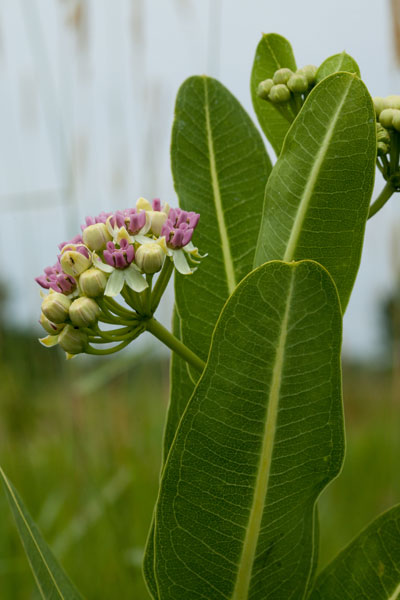 Unusual color form of Sullivant's milkweed. July 7 4, 2009. Marion County, Ohio. Milkweed references
generally state that the plants are pollinated by a general array of
large bees and lepidopterans, the latter mainly butterflies. Here's
an instance that seems to support this statement,
as honeybees (honeybee
actually ...the lower one is stuck fast to the blossom and thus isn't
doing a lot of foraging), and a bronzed copper butterfly, forage on a
plant.
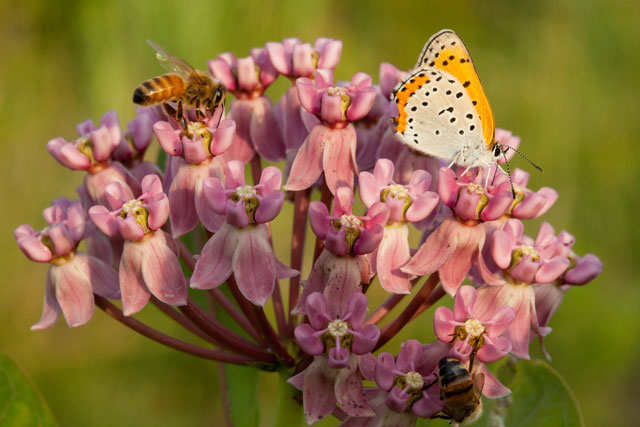 Bronzed copper and honeybee foraging on Sullivant's milkweed. July 20, 2009. That picture was
snapped during a video shoot. Here's the video.
Bronzed copper butterfly and honeybee forage on Sullivant's milkweed. It is a misleading
picture and video
because, during
the daytime at least, the plants are avidly feasted upon by bees,
nearly
all of which are (non-native!) honeybees. Joining them
are just a
few bumblebees. The bumblebees seem to dart on and off the
flower
clusters
rather quickly, in contrast to the honeybees, which spend more time
on a given cluster, going from flower to flower there. Hence I have a
lot of pics of honeybees, and no good bumblebee ones. But that's OK
because the honeybees are apparently the predominant pollinators, by
far, so they deserve the attention. And butterfly visits for nectar are
extremely rare. (Monarchs are fairly common, but they are mainly
engaged in mating and egg-laying.)
...and sleeping I guess. Here's a monarch butterfly moist with early morning dew where it apparently spent the night, on swamp milkweed (Asclepias incarnata). 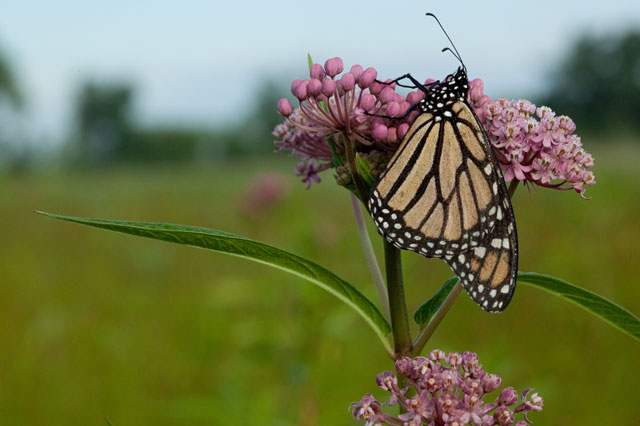 Swamp milkweed and monarch butterfly. July 8, 2009. Killdeer Plains Wiildlife Area. The individual masses of pollen are pollinia, consisting of the entire pollen production --typically a little over 100 grains --of one half-anther. They are paired --one pollinium each from adjacent stamens --into wishbone-shaped structures called "pollinaria" that are withdrawn accidentally/incidentally as a bee's foot drags upwards along the central columnar portion of the flower (a specialized compound structure termed the "gynostegium") and catches into a teeny slit on the black knob-like corpusculum at the top of the wishbone. Bees will typically carry several several pollinaria on several legs, and often several on a single leg!. Here's an enlarged view of a bee on swamp milkweed a few years ago, carrying an insanely large number of pollinaria. 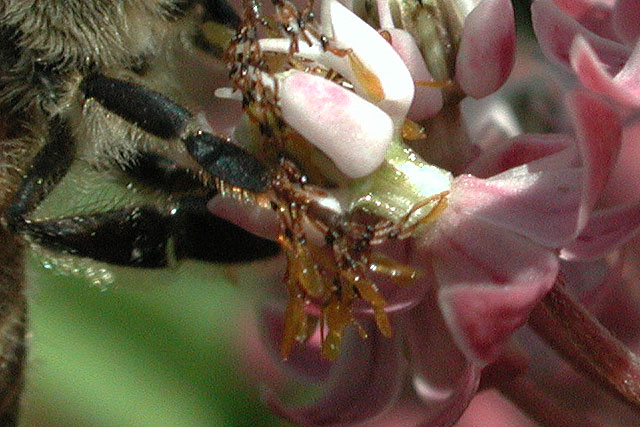 Honeybee legs with a great many pollinaria. July 30, 2003. OSU Marion. This is a set of studio photos showing the central portion of a milkweed flower in three configurations with respect to polliniaria. They were transferred by hand, using forceps. Forceps are the same as tweezers, only more expensive since they're for science! 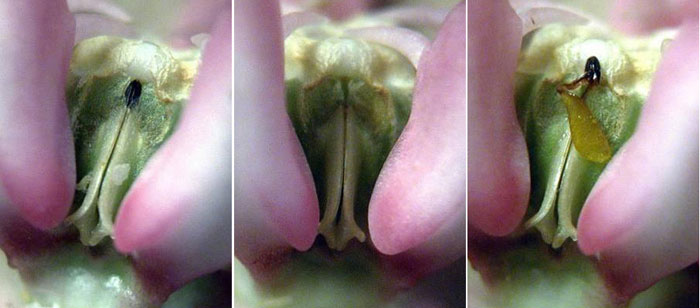 Closeup of portion of Sullivant's milkweed gynostegium, showing stigmatic groove. Left: pollinarium of same flower in place (not removed). Center: pollinarium of same flower removed. Right: foreign pollinarium with one of its 2 pollinia inserted into groove (not visible). Here are some videos
showing the hand-pollination of milkweeds.
Video of milkweed
pollinarium removal.
And now the insertion.
Video of
hand-pollination of milkweed flower.
Here are
photomicrographs of the pollinaria of both Sullivant's milkweed ("sullivantii")
and common milkweed ("syriaca"). The arm-like
connection between the pollen-filled half-anther and the corpusculum is
the "translator," the lower end of which is both bent and flattened.
The bent flat spot is the portion that catches in and first enters the
stigmatic groove. As the corpusculum is drawn upwards by the
pollinating insect situated outside the grove, the pollinium
is dragged along inside
the groove, finally coming to rest along the stigmatic
surface.
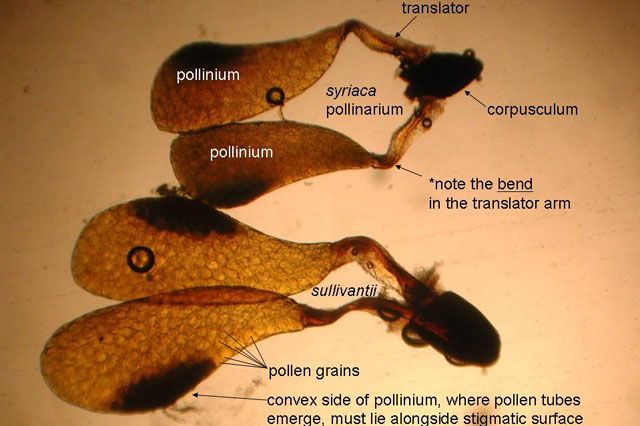 Milkweed pollinaria through a microscope. Below, a
cross-section exposing the stigmatic chamber of a pollinated
flower.
MOUSEOVER the IMAGE
for closeup of stigmatic surface and presumed path of pollen tubes.
Note the two
ovaries,
each of which can potentially develop into a
fruit.
The
following series of
cross-sections illustrates an interesting
peculiarity of milkweed flower structure with respect to pollination.
The gynoecium includes two separate ovaries. One of them can be
fertilized by pollinia inserted into either of two adjacent
stigmatic chambers, while the other ovary is serviced by any
of the three other chambers. Atop the
thimble-shaped gynostegium column, a shallow but distinct linear
depression marks the boundary between these funtionally separate
stigma-style-ovary units. CLICK on the "SLICE" links just above the
photo to to
see three transverse slices through the gynostegium.
TOP SLICE MIDDLE SLICE BOTTOM SLICE NO SLICE
Details of milkweed gynoecium. An interesting
consequence of having two ovaries per flower is the fact that, if two
pollina
are inserted into separate chambers each of which connects to a
different ovary, "twin" fruits can occur. (Note that they are "twinned"
only in the sense of being paired. They not genetically
twinned. With respect to parentage, they are the same as any other two
fruits on the same plant --half sibs, unless there is a great
coincidence.)
Here's a picture set from a few years ago shows pseudo-twinning on common milkweed (A. syriaca). 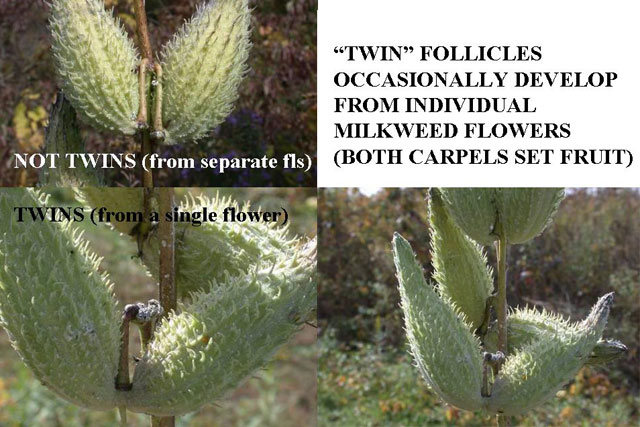 Because milkweed flowers have two ovaries, two fruits can develop from one flower. MOUSEOVER the
IMAGE
for closeup of bee's pollinium-carrying leg.
Note already-pollinated flower in foreground. Honeybee foraging on
milkweed. July 20, 2009. Killdeer Plains Wildlife Area.
...and here is another
example:
MOUSEOVER the IMAGE for closeup of bee and pollinium. Honeybee foraging on
milkweed. July 20, 2009. Killdeer Plains Wildlife Area,
Looking straight
down on a flower,
it is evident that the large size and the curvature of the base of the
nectar-filled hoods conspire to direct the bees leg towards
the
spot where it needs to be to effect pollination.
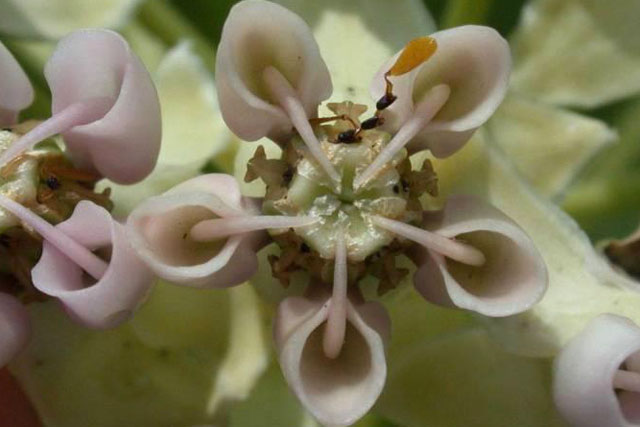 "Aerial" view of milkweed flower. Note some inserted and removed pollinaria. With this perspective,
observations of the
flower-to-flower amblings of a honeybee on a milkweed umbel can be made
with our attention focussed on on her legs and feet. Although I've
never seen or photographed an actual pollinarium removal or pollinium
insertion, it's clear that the bees are carrying pollinaria, and their
feet
are naturally and repeatedly dragged upwards along the stigmatic
groove.
Here's what that looks like. Honeybees forage on
Sullivant's milkweed. July 4, 2009. Killdeer Plains Wildlife Area.
Milkweed
flowers are
produced in
umbels of about 20-40 flowers each, in which all the flowers
bloom
simultaneously. The flowers last for about 5 days, and during this
period they are open and potentially available to pollinators around
the clock.
This raises the question: Is there any night-time pollination of Sullivant's milkweed at Killdeer Plains? Curious whether there might be a substantial night-time pollination operating here, I did a bagging study. A few days before the evening of July 7, 2009, I placed a nylon mesh bag over umbels that were just about to flower --one umbel each on 90 plants. They were broken down into three groups of thirty plants each, randomly chosen according to when they would have their bag removed and thus be exposed to pollinators. The three groups were: (1) nightime only, (2) daytime only, and (3) both night and day. The experiment lasted 3 days (and nights). Here is the scene with the plants flagged, an early morning shot. 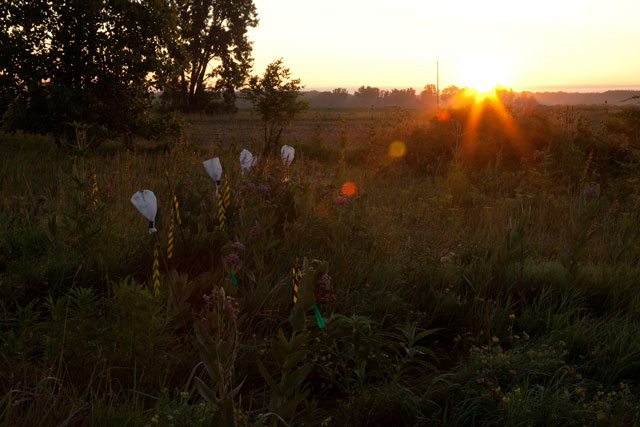 Milkweed plants being studied for timing of pollination. July 8, 2009. Killdeer Plains Wildlife Area. Just walking around at
night, it is obvious that there are almost no nocturnal visitors to the
flowers. Nevertheless, I took pics of the few that were seen.
Here's a biggish moth. Note the long proboscis extending into the nectar-filled "hood." 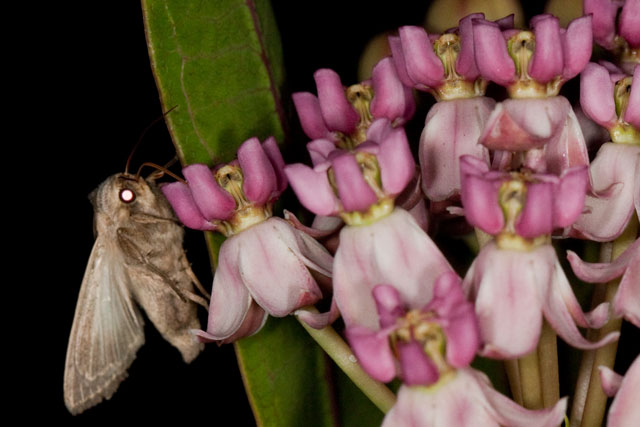 Largish moth drinking milkweed nectar evening of July 8, 2009, at Killdeer Plains. Here's a smallish
moth with its face well down into the cup.
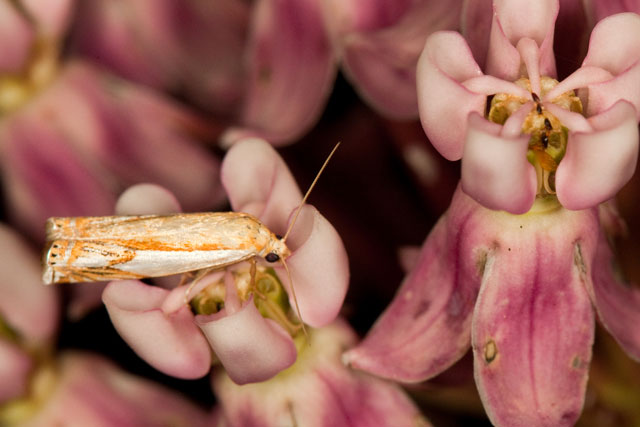 Smallish moth on Sullivant's milkweed, evening of July 8, 2009 at Killdeer Plains wildlife Area. ...and here's a mediumish moth. 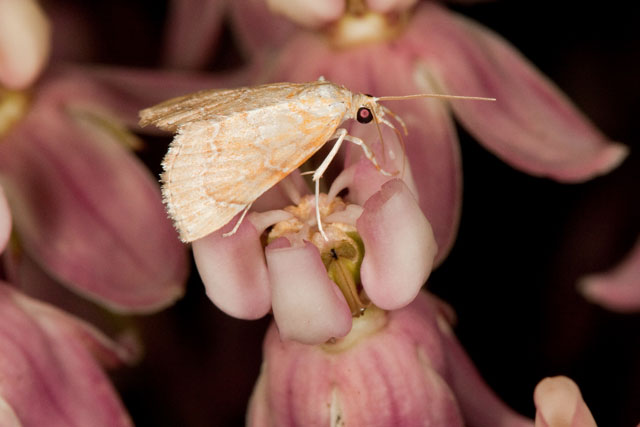 Yet another moth on Sully's m-weed. July 8, 2009. Largish moth? Smallish moth? Yet another moth? Where's this guy when you need him?  Car belonging to someone whose expertise would come in handy right now. 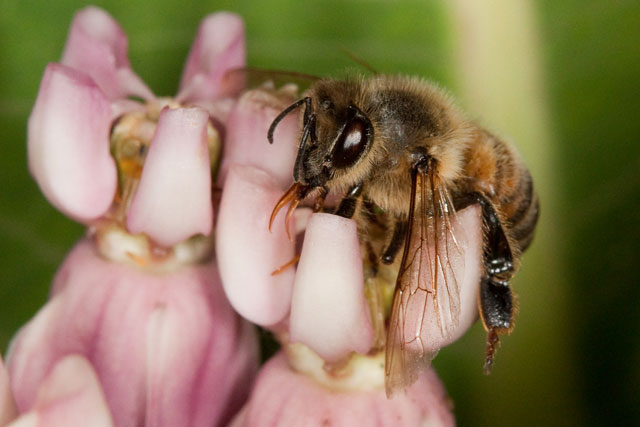 Bee just before midnight, trapped on milkweed flower. July 8, 2009. Not for the
faint-of-heart, here's a honeybee having a bad day, as she is
struggling, aparently in vain, to extricate herself from a tight spot.
Honeybee snagged by
milkweed at Killbee Plains Wildlife Area.
Well, that bee's bad day is no worse than the one had by the bee shown below. There are signs this bee had several bad days before this worst one. Note that her feet (tarsi) are gone from all of her legs! Most likely she was caught several times on milkweed flowers and, while managing to break free, her feet remained attached to the flowers! 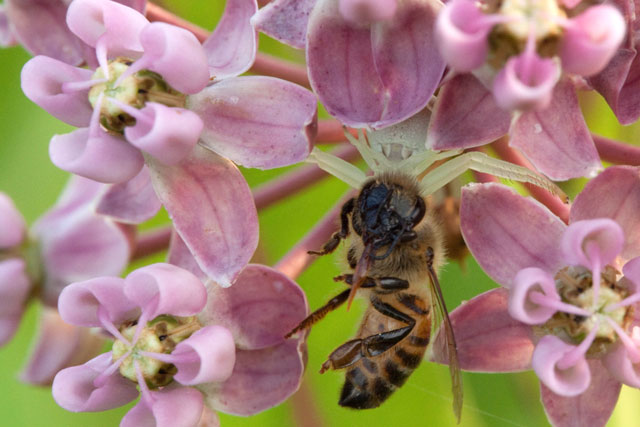 Honeybee in jaws of
crab spider. July 10, 2009. Killbee Plains Wildlife
Area.
Meanwhile, at night while hardly any moths were visiting Sullivant's milkweed flowers but I took their pictures anyway, hardly any moths were visting common milkweed (A. syriaca) flowers, but I took their pictures anyway. 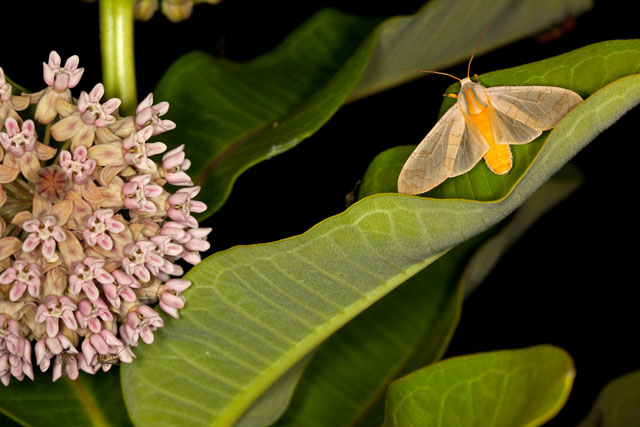 Common milkweed and moth at Killdeer Plains Wildlife Area. July 8, 2009. After the three days
(and nights) were up, and in a zombie-like trance owing to sleep
deprivation, I plucked all 90 flowers clusters and took them
home to be scored for pollinator activity. One of the many great things
about milkweeds is that pollination can be assessed in a
straightforward
manner. One can score "male function" by counting the number of
pollinaria that have been withdrawn (out of 5 possible), and "female
function," by peeking into the stigmatic chamber to note whether or not
a pollinium has been inserted there (also 5 possible insertion
sites).
The results are dramatic. Among the 29 daytime-exposed plants that were tallied (10 flowers per plant), there was an average of 1.6 pollinarium removals per flower. Since there are 5 pollinaria/flower, this amounted to an approx. 32% removal rate. For the (also 29) night-time exposed plants, the removal rate was practically nil --less than 1%. Daytime pollinium insertions, at 28%, were only slightly fewer than removals and, in similar relative fashion to the removal rates, nightime flowers had an uber- miniscule insertion rate of less than one half of one percent (based on 5 chambers per flower). Conclusion? Despite intriguing sightings of a few moths here and there, a typical night shot of Sullivant's milkweed looks like this. 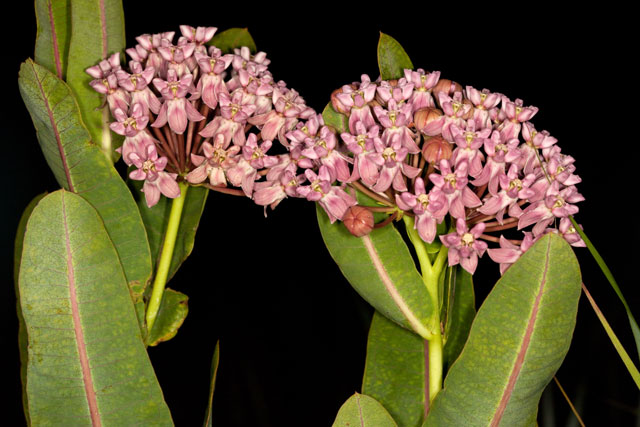 Nightime at the milkweed prairie. July 8, 2009. Killdeer Plains Wildlife Area. It's odd to see such an underexploited resource, especially considering that moths are adapted for nectar-drinking, and the flower clusters of Sullivant's milkweed, held more stiffly upright than some other milkweeds, would be easy for them to perch upon. 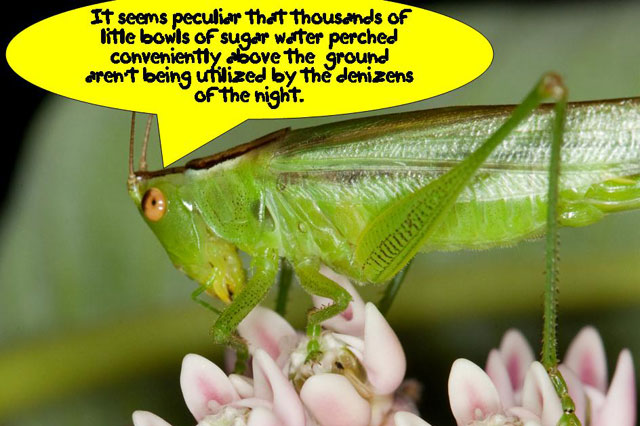 Grasshopper on common milkweed ponders ecology. Kildeer Plains. July 8, 2009. Perhaps it is worth
noting that
yes, there are flowers in our area pollinated by night-flying
moths. In the nearby town of Morral there is a thriving stand of
jimson-weed (Datura stramonium, family
Solanaceae). This, one of our most poisonous plants, in an
alien with quite handsome flowers.
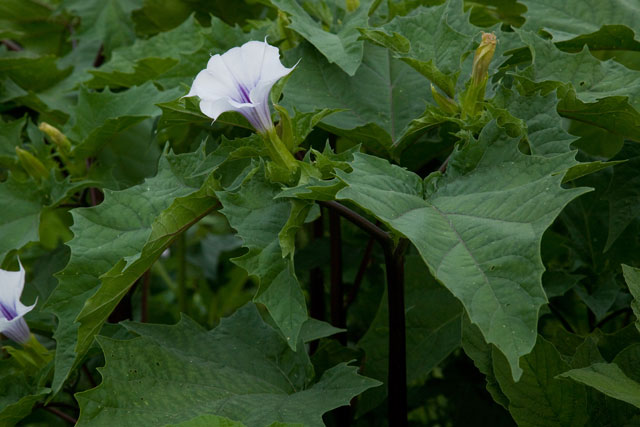 Jimson-weed, a night-blooming, moth-pollinated plant. Morral, Marion County, Ohio. July 10, 2009. |
